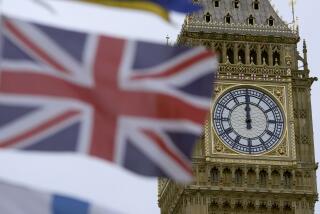Britain’s ‘Loony Left’ May Lose Labor Voters
LONDON — If--or, more probably, when--Margaret Thatcher’s Conservatives win a third term this Thursday, the opposition Labor Party will have reached a watershed. Over the short, intense weeks that characterize a British election campaign, many Labor supporters have sought comfort in the party’s stirring revival under Neil Kinnock, its progress in the opinion polls and its new-found mastery of media and imagery.
To be sure, Labor has rebounded from the fiasco of the 1983 election, when it appeared on the verge of self-destructing. Under Kinnock, the party now looks relatively united. His call for a return to the politics of compassion scores points; so do his scalding rhetorical attacks on Prime Minister Thatcher for arrogance and insensitivity, and the wanton devastation of Britain’s inner-cities--areas where her aides acknowledge she is most vulnerable.
Yet the Dickensian wasteland that Kinnock describes may also be a window into Labor’s long-term problems. For Thatcherism has wrought profound demographic changes in Britain--changes that may have wrecked future prospects for a return to mass-based Social Democratic government. Eight years of Conservative rule have changed the face of the electorate, and with it the face of the Labor Party. Above all, it has given birth to a radical and unruly left wing, bred largely in London and ruined urban areas, that may prove to be Kinnock’s greatest electoral liability.
The solidly Thatcherite south of England has been revolutionized, turned into a high-tech service platform infused with the ethic of self-reliance and individual advancement. Dull commuter hubs like Bracknell, Basingstoke and the old railway center of Swindon have been converted into sleek boom towns ringed by gleaming industrial parks. At the other end of the spectrum are the northern graveyards of traditional heavy industry, towns like Birkenhead, Middlesbrough and South Shields.
As blue collars are exchanged for white, Labor’s traditional bastions of unionized, working-class support are dissolving. Among the Conservatives’ most popular moves was allowing tenants in public housing to buy their own homes. One million have taken advantage of the scheme, and a majority of them will probably vote Tory on Thursday. At the same time, the trade unions, on which Labor has relied more heavily than any other Western European party, have declined sharply in both numbers (only 22% of British workers are now unionized) and credibility--their collapse symbolized in Thatcher’s crushing victory over striking mine workers two years ago.
While one segment of the old working class has tasted the pleasures of upward mobility, another has slid rapidly, perhaps irrevocably, downhill. Britain now has a solid 3 million unemployed, the core of a disenfranchised underclass that inhabits the blighted inner cities.
The self-proclaimed champions of the inner cities are a new breed of local Labor activists, who moved into a vacuum created by an exodus of middle-of-the-road party members during the 1970s. It was Rupert Murdoch’s ferocious tabloid daily, the Sun, that first dubbed them the “Loony Left.” Some belonged to extreme leftist groupings on the fringe of the party, such as the Trotskyist Militant Tendency. Others emerged from the issue-oriented politics of the 1960s, thrusting the issues of radical feminism, gay and lesbian rights and militant anti-racism to center stage. A vicious circle soon developed: Each new government cutback of funding and services brought a new sense of marginality to the inner cities and an ever greater stridency to their politics. Thatcher’s response was to bypass local government powers altogether, a campaign climaxed by abolition of the Greater London Council in 1985.
The British tabloids have run riot with the Labor-controlled city councils. In the popular papers’ overheated imagination, children are being indoctrinated in hatred for the nuclear family while councils ban black garbage sacks because they are racist and manholes because the term is sexist. A study by London University’s Goldsmith’s College concluded that many “Loony Left” stories were “either deliberately distorted or simply invented.” Yet the fabrications were spun around a grain of truth, and the damage was done.
The new style of Labor politics in the cities often appeared to neglect bread-and-butter economic issues affecting its constituents. It was a confrontational style that placed a premium on gestures and symbols: an African National Congress flag flying over the Town Hall; Nicaraguan sister-city projects, and invitations for Sinn Fein councilors from Northern Ireland to address local councils.
The style derived from a belief that the consensus politics favored by Labor in the past, far from being the solution, was directly to blame for the plight of minorities under Tory rule. By this reckoning, it was logical to pay less attention to the concerns of white industrial workers than to those of, say, black lesbians, who had to contend with the additional disadvantages of gender and race.
The Labor Party has spent much of the last eight years in this poisoned atmosphere, its leadership at war with doctrinaire fringes. The most damaging pre-election fight has been with members of the party’s newly formed “Black Sections.” Whatever the outcome on Thursday, Britain will have a cluster of Black members of Parliament for the first time since 1924. But race has entered the campaign in a manner reminiscent of the brief eruption of “black power” on the U.S. political scene in the late 1960s. The focus of the battle has been Sharon Atkin, a black candidate for the Tory-held constituency of Nottingham East, who declared that, “I don’t give a damn about Neil Kinnock and the racist Labor Party,” reviling the Labor leader as a “class traitor.”
Thatcher now speaks openly of eradicating socialism from Britain’s political landscape. For most of the surviving structures of local government and the postwar welfare state, what she has in mind is death by a thousand cuts, taking private huge swathes of public health, education and municipal services. In the inner cities, the response is likely to be a greater virulence rather than a new moderation.
If Labor loses on Thursday, its choice will lie somewhere between a shake-up and a blood bath. Defeat will surely lead to a call for open war on the radical left; those who scared off voters by pushing the issues of race and sexuality to the forefront of Labor’s campaign will be blamed by many party members anxious to find scapegoats.
But the party will also have to acknowledge that its problem is less one of image--which Kinnock has solved skillfully--than of demographics. Can a renewed Labor Party emerge, capable of reaching the workers in declining smokestack industries, the upwardly mobile consumers with a social conscience and the ravaged urban underclass? If not, Thatcher may well realize her dream of remaining in power, like Queen Victoria, until the end of the century.
More to Read
Get the L.A. Times Politics newsletter
Deeply reported insights into legislation, politics and policy from Sacramento, Washington and beyond. In your inbox three times per week.
You may occasionally receive promotional content from the Los Angeles Times.










